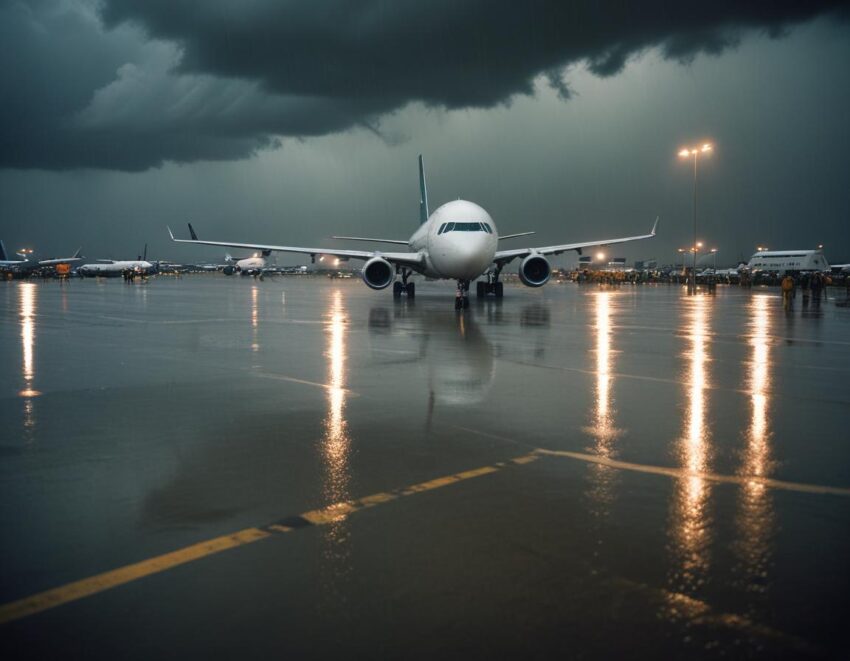Published on
August 20, 2025
By: Tuhin Sarkar

Indian city Mumbai has now joined Mexico City, South Taiwan, and Hong Kong in facing major travel chaos as heavy rains and flooding disrupt air travel. At Mumbai’s Chhatrapati Shivaji Maharaj International Airport, the world’s busiest single-runway hub, operations slowed to crisis levels as poor visibility and waterlogged runways triggered diversions and delays. In just one day, more than 11 flights were diverted and 24 go-arounds attempted, leaving thousands of passengers stranded or rerouted. Similar chaos unfolded in Mexico City where flooded runways forced dozens of cancellations, while Taiwan grounded hundreds of flights due to Typhoon Podul. Hong Kong also struggled with its heaviest August rainfall in over a century, paralysing its global gateway. Together, these events highlight how extreme weather is now a growing threat to aviation, tourism, and passenger confidence, with travellers across Asia and the Americas caught in disruption beyond their control.
Why Heavy Rains Brought Mumbai’s Airport to a Standstill
Mumbai rains disrupt air travel every monsoon, but August 2025 has brought extreme challenges. At Chhatrapati Shivaji Maharaj International Airport, operations slowed to a crawl. On Tuesday alone, 11 flights were diverted and 24 go-arounds attempted due to poor visibility. With average landing delays of nearly one hour, airlines and passengers faced massive disruption. The world’s busiest single-runway airport could not cope with the combination of heavy downpours, waterlogging, and air congestion. Travellers endured cancellations, diversions, and endless waiting. For Mumbai and India’s aviation sector, this week shows the impact of climate and infrastructure stress on one of Asia’s largest hubs.
Flights Diverted and Go-Arounds Rise
The rains caused serious operational stress at CSMIA. On Monday, 10 flights had to attempt go-arounds and one was diverted. But conditions worsened on Tuesday. Poor runway visibility and heavy rainfall forced 24 aircraft to attempt missed approaches. Eleven flights were diverted to other airports, including Pune and Ahmedabad. For airlines, diversions mean increased costs in fuel, crew time, and logistics. For passengers, they mean missed connections and frustration. The pressure on a single-runway operation is immense when visibility collapses.
Introduction: Rain Turns Airports Into Chaos Zones
August 2025 has brought scenes of chaos at some of the world’s busiest airports. From Mumbai in India to Mexico City, from Hong Kong to Taiwan and Pakistan, torrential rains have left runways waterlogged, terminals crowded, and schedules in disarray. Hundreds of flights have been cancelled or diverted. Thousands of passengers are stranded. For the global travel industry, this month is a stark reminder of how extreme weather can paralyse aviation networks. For travellers, it is another test of patience and resilience.
Mumbai Airport Paralysed by Relentless Monsoon
Mumbai, India’s financial capital, has been battered by relentless rainfall. At Chhatrapati Shivaji Maharaj International Airport, the world’s busiest single-runway hub, operations slowed to a standstill. On Tuesday, 11 flights were diverted to alternate airports and 24 aircraft were forced into go-arounds. Cancellations spread across domestic and international routes. Azerbaijan Airlines cut its service to Baku. IndiGo cancelled nine domestic flights, leaving passengers stranded across India.
Flightradar24 reported the airport disruption index at 5.0, signalling severe problems. Landing delays reached 54 minutes on average, while departures were held up by over 50 minutes. With over 250 flights delayed or cancelled in two days, the airport became a symbol of how fragile infrastructure is when torrential rain and poor visibility combine. For travellers, long queues, missed connections, and night-long waits for rebooking added to the frustration.
Mexico City Battles Flooded Runways
Thousands of kilometres away, Mexico City’s Benito Juárez International Airport faced its own storm-driven crisis. Torrential rain flooded runways, forcing hours-long suspensions of operations. More than 70 flights were diverted, including some rerouted 800 miles away. Nearly 90 flights were cancelled outright. Some aircraft were forced into “flights to nowhere,” taking off only to return to their origin because they could not land in Mexico City.
For airlines, the costs of fuel, repositioning, and disrupted crew schedules mounted rapidly. For passengers, confusion reigned. Terminals overflowed with stranded travellers, and customer service lines stretched for hours. This crisis hit during one of the busiest travel months of the year, amplifying the damage to Mexico’s tourism economy.
Typhoon Podul Grounds Flights in Taiwan
In southern Taiwan, Typhoon Podul unleashed its fury in mid-August. Winds and torrential rains forced the cancellation of 252 domestic flights and 129 international flights. Airports across the island struggled with cancellations, diversions, and emergency sheltering. Airlines had no choice but to ground fleets until conditions improved. For Taiwan, an island dependent on air connectivity, the storm’s impact was severe. Tourism, business travel, and cargo flights were all disrupted. Passengers attempting to travel to or from Taipei and Kaohsiung faced days of uncertainty.
Hong Kong Reels From Heaviest August Rain in 140 Years
Hong Kong suffered its heaviest August rainfall since 1884. Authorities issued black rainstorm warnings, the highest tier of weather alerts. The downpour overwhelmed drainage systems and triggered flash floods across the city. At Hong Kong International Airport, visibility collapsed and operations slowed. Airlines warned of long delays, cancellations, and diversions.
The timing could not have been worse. Hong Kong has been rebuilding its tourism industry after years of pandemic-related decline. The sudden flood disrupted flights from mainland China, Southeast Asia, and long-haul routes to Europe and the United States. For airlines, the cost of missed connections and disrupted rotations was enormous. For travellers, cancelled holidays and disrupted business trips added to frustration.
Pakistan’s Airports Disrupted by Monsoon Flooding
In Islamabad and Karachi, heavy monsoon rains created havoc. Flight schedules were suspended as water flooded runways and terminals struggled with leaks and power outages. Airlines cancelled or delayed dozens of domestic and regional services. Passengers faced long waits as staff battled conditions beyond their control. For Pakistan, already grappling with fragile infrastructure, the rain chaos highlighted how quickly normal operations can collapse under extreme weather pressure.
Departure Delays and Congestion
Flight tracking platforms reported severe departure congestion. Flightradar24 noted that the airport disruption index touched 5.0, signifying severe problems. This index indicates high delays, long holding patterns, and widespread cancellations. Average departure delays touched 51 minutes, while average arrival delays reached 54 minutes. With hundreds of flights daily, each delay multiplied across the system. Congestion built both in the skies and at terminal gates. Travellers waited for hours as departure screens flashed red with delays and cancellations.
Airlines Forced to Cancel
Several carriers cancelled services on Tuesday due to the worsening weather. Azerbaijan Airlines cancelled its flight to Baku. IndiGo, India’s largest carrier, cancelled nine flights across domestic destinations including Bengaluru, Ahmedabad, Chennai, Indore, Patna, Vadodara, Aurangabad, and Guwahati. Other airlines issued travel advisories warning of congestion and visibility issues. For India’s aviation sector, these cancellations highlight the vulnerability of tight schedules when monsoon storms hit. Each cancellation triggers a chain of rebookings, refunds, and customer complaints.
Passenger Experience at Breaking Point
For passengers, the disruption was chaotic. Families and business travellers stuck at the terminal struggled to get information. Airlines issued advisories but gate staff faced crowds of anxious passengers. Many were redirected to buses and hotels after diversions. Others faced night-long waits for rebookings. International passengers missed onward connections at global hubs. Domestic passengers lost valuable working days. The frustration spread across social media, where images of crowded terminals and waterlogged runways went viral.
Tourism and Hotel Impact
Mumbai’s tourism and hospitality sectors also felt the shock. Hotels near the airport saw an unexpected surge in stranded passengers needing overnight stays. For premium hotels, this brought a temporary boost. But cancellations of flights carrying leisure and business tourists hurt revenues elsewhere in the city. Tour operators reported cancellations of same-day and next-day packages. The ripple effect extended to Goa, Rajasthan, and Kerala, where connecting flights were cancelled. The tourism economy across western India faced losses as rain chaos disrupted travel plans.
Airlines and Crew Struggle with Scheduling
The weather disruption strained airline operations. Crew duty hours were stretched with long diversions and delays. Aircraft rotations broke down, forcing cascading cancellations. For low-cost carriers with tight schedules, the disruption was even more severe. International carriers faced difficulty repositioning aircraft and ensuring rest periods for crew. The rains showed how vulnerable airlines are when infrastructure is stretched. With only one operational runway at Mumbai, the margin for error is small.
Infrastructure Under Pressure
Mumbai’s airport is the world’s busiest single-runway operation. Handling hundreds of flights daily, it operates close to capacity even in normal conditions. Heavy rain, poor visibility, and waterlogging expose its limits. Calls for expanding capacity or upgrading infrastructure grow stronger with each monsoon. While Navi Mumbai’s new airport is under development, delays in its launch mean CSMIA continues to face overwhelming pressure. Until additional capacity arrives, each monsoon season risks paralysing India’s financial capital.
Aviation Policy and Climate Stress
The August 2025 rains highlight a growing issue: climate change and urban flooding are now aviation challenges. Heavy rainfall events are becoming more frequent. Airports like Mumbai, with constrained layouts, suffer heavily. Policy makers must plan for better drainage, advanced radar systems, and stronger weather protocols. Airlines need contingency planning for diversions and better customer communication. Without these, each storm becomes a crisis.
Wider Impact on the Travel Industry
The disruption at CSMIA reverberated across India’s travel industry. Connecting passengers missed flights at Delhi, Bengaluru, and Hyderabad. Hotels in Mumbai were overbooked with stranded tourists. Business meetings were cancelled. International visitors arriving in India formed negative impressions of reliability. For an industry already challenged by rising fuel costs and global economic uncertainty, weather-related chaos adds fresh risk. The travel and tourism ecosystem needs resilience planning to maintain confidence.
Lessons for Travellers
For travellers, the lesson is to prepare for monsoon uncertainty. Flexible tickets, travel insurance, and buffer time are essential. Airlines offer waivers during extreme events, but rebooking may still take hours. Choosing morning flights may reduce risk during heavy-rain days, as weather often worsens later. Understanding that airports like Mumbai face structural limits can help travellers plan better.
Conclusion: Urgent Need for Resilience
The Mumbai rains of August 2025 once again showed how fragile aviation systems are during monsoon extremes. Eleven diversions, 24 go-arounds, dozens of cancellations, and hours of delays caused chaos. Passengers endured frustration. Airlines faced losses. Hotels scrambled to adjust. Tourism across western India felt the ripple. For Mumbai, the only answer is infrastructure resilience, faster completion of Navi Mumbai Airport, and stronger climate adaptation. Until then, each heavy downpour will remain a risk to travel, tourism, and confidence in India’s busiest aviation hub.








